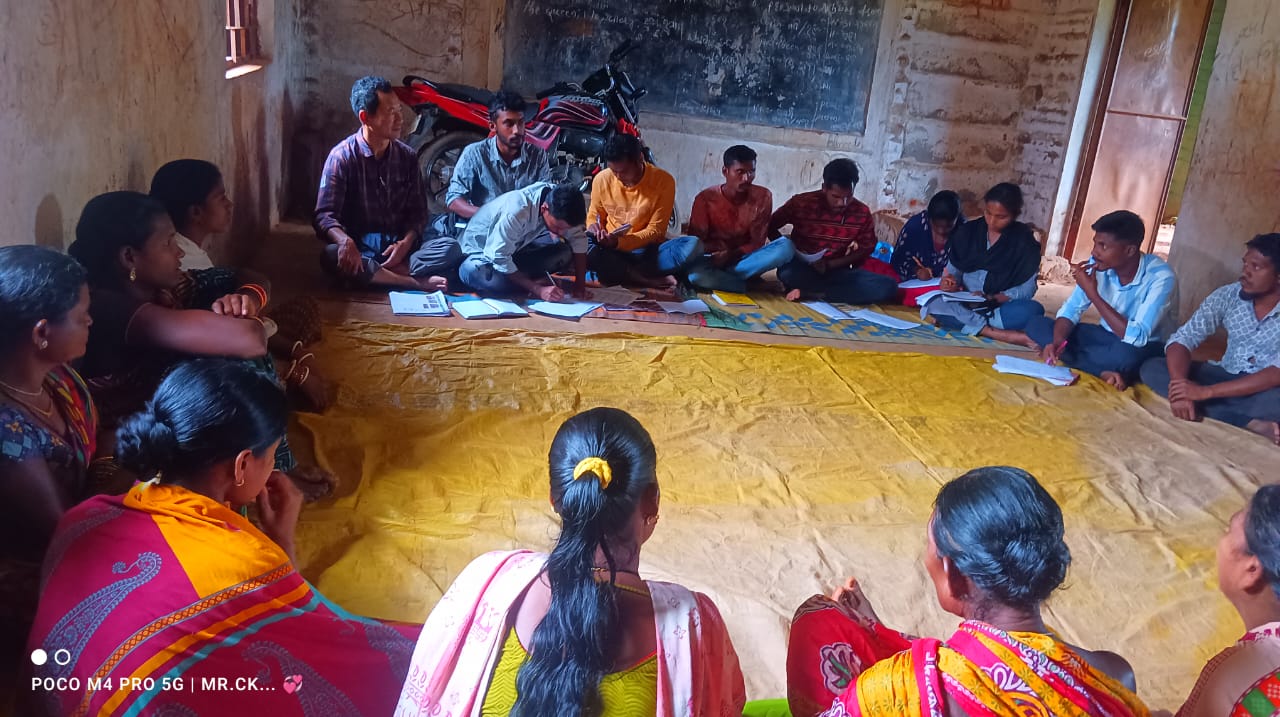A remote Adivasi village takes steps to ease water stress through efficient groundwater management
FeatureBy Anas K P
25 March 2024

Discussion on identifying critical water source in Poiguda village. Photographs by Dulamani Sahu
“It’s reassuring to learn that mapping all the water sources within our village is complete. Given the recurrent water scarcity we experience during the summer, understanding how much water a water source holds is crucial. This knowledge will help us proactively manage our water resources and prevent future water crises during summers,” emphasises Subhash Gouda.
Subhash, 35, is a farmer and Secretary of the Poiguda Village Development Committee (VDC) and a member of Maa Lankeshwari Krusaka Utpadaka Goshti, a Farmer Producer Group (FPG) in the Poiguda village in the Sindhipadar Panchayat of Kalahandi district.
Recognising the availability and sustainability of water sources is paramount for communities, particularly in areas grappling with water scarcity. Water Security Plans (WSP), developed at both the habitation and Gram Panchayat levels, are vital for facilitating efficient resource management initiatives. These plans are not only essential but are also community-owned and managed, ensuring their effectiveness.
During a community meeting held in Poiguda village, Akhil Sunani, 30, a farmer and the President of Maa Lankeshwari Krusaka Utpadaka Goshti, a Farmer Producer Group (FPG) in the village, explained the significance of the water sources.
He articulated, “Our village primarily relies on two vital water sources: the Jena Jharana, which supplies water to every household through a piped water system, and the Bhimamaska Jharana, mainly utilised by farmers for crop irrigation and livestock. Safeguarding these two sources and the others is paramount as our survival hinges on them.”
Aquifers hidden beneath the porous rock, soil, or gravel layers are reservoirs for storing and transmitting water.
Nevertheless, it is paramount to acknowledge that groundwater is a finite resource, and upholding its sustainability is vital for securing long-term access to water. Groundwater in the aquifer serves as the primary water source for drinking, domestic use, irrigation, livelihood activities and livestock support. Aquifers represent a crucial community pool resource, playing a vital role in shaping the overall water security of a village.
Mature-based land use planning is equally crucial, as it plays an important role in groundwater management and ultimately contributes to a sustainable and water-secure village.
Participatory groundwater management is paramount to managing groundwater as a community resource effectively. This approach entails engaging the community in the oversight, regulation, and sustainable planning of aquifer usage.
Community-led initiatives, conducted per established groundwater management protocols, foster judicious groundwater utilisation.
Frequent awareness meetings, demonstrated by the one convened in Poiguda village, are essential in equipping village communities with the knowledge to make informed decisions concerning water usage, conservation, and preservation.
Bhanumati Majhi, 31, President of Kanyakumari SHG in Poiguda village, highlights how the ongoing meetings with Gram Vikas have helped the sixty-six households in the village to collaborate and recognise water as a shared community resource. This collective understanding has been instrumental in addressing the village’s water security concerns and aspirations, ultimately paving the way for developing a comprehensive water security plan for the entire community.
Water resource planning is an important component of Gram Vikas’ Water Secure Gram Panchayat (WSGP) programme. The Village Development Committee (VDC) leads the planning initiatives within each habitation. They collaborate closely with the Gram Panchayat Coordination Committee (GPCC), a body that represents the federation of VDCs within a Gram Panchayat, to ensure the efficient pooling of resources.
The water security plan at the Gram Panchayat level plays a crucial role in fostering coordination among different habitations and promoting participatory governance of water resources within the Gram Panchayat.
The Gram Panchayat Coordination Committee (GPCC) is an inclusive body representing all habitations within the panchayat. The comprehensive Water Security Plans (WSPs) from all habitations within the GP will be compiled and presented to the GPCC. Subsequently, the GPCC deliberates and prioritises the work demands submitted by the Village Development Committees (VDCs) for the coming years.
A prioritised Water Security Plan (WSP) at the Gram Panchayat (GP) level must be formulated and presented during the Gram Sabha meeting for integration into the Gram Panchayat Development Plan (GPDP) for the convergence with the Gram panchayat and other government institutions.
The Water Security Plan is crucial to Gram Vikas’ Water Secure Gram Panchayat (WSGP) Programme. Currently, Gram Vikas works in 71 Gram Panchayats, reaching 84,078 households in nine districts in Odisha and Jharkhand.
Making water security plan along with the community members of Poiguda village. Photograph by Dulamani Sahu.
ACKNOWLEDGEMENT
Dulamani Sahu collected data, and is a field expert in the Water Source Sustainability team. Priya Pillai edited the piece.
ABOUT THE AUTHOR
Anas K P is the team leader of Gram Vikas' Water Resource Technology Group (WRTG).
RELATED BLOGPOSTS
From stigma to sustainability: Transforming menstrual health in schools and villages of rural Odisha
A menstrual health initiative promotes eco-friendly practices while empowering young girls and women with sustainable health solutions.
Lost words, found voices: A language revival adventure in rural Gajapati
An SBI YFI Fellow learns Saura and works with students to create an audio-visual dictionary.
Cultivating change: using greywater for enhancing dietary diversity
A collaborative research initiative to enhance dietary diversity through greywater innovation in Ganjam and Gajapati districts of Odisha.